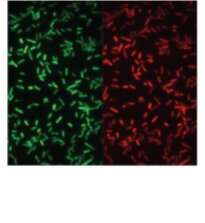The optimal design of cellular sensing systems

To survive and prosper, living cells continually respond and adapt to changes in their environment. To this end, they have developed sensing systems that rival the best man-made sensing devices. Yet, how accurately these systems can measure chemical concentrations remains poorly understood. Researchers from AMOLF have now developed a theory that predicts the optimal design that maximizes the sensing precision of these systems. An analysis of experimental data revealed that the sensing system of the bacterium E. coli obeys the design principles as predicted by their theory. The AMOLF team presented their work in the journal eLife.
Living cells, including bacteria searching for food and cells differentiating inside an embryo, continually respond to signals in their environment. These signals are typically chemical concentrations of some species—proteins or food molecules. Cells have developed dedicated sensing systems that enable them to measure such chemical concentrations.
Like any information-processing device, resources are required to build and operate the cellular sensing system. Components are needed to construct the system, time is needed to process the information, and energy is required to process the information reliably. Yet, how these resources constrain the sensing performance was not understood.

The AMOLF researchers have now developed a theory that allows them to predict the optimal design of cellular sensing systems. This optimal design maximizes the sensing precision given constraints on the availability of the cellular resources. The theory allows the researchers to predict how much energy and how many proteins are needed to reach a required sensing precision, and how this depends on the speed and strength of the signal fluctuations in the environment.
The researchers applied their theory to the best-characterized sensing system in biology, the chemotaxis system of E. coli. It has been known for a long time that this system can detect extremely small concentration changes, which vary by less than a pro mille over the body length of the bacterium. Measuring such shallow concentration gradients is very challenging. The theory of the authors predicts that E. coli can nonetheless do so precisely because its sensing system has been designed optimally, leaving no resource wasted.
More information: Giulia Malaguti et al. Theory for the optimal detection of time-varying signals in cellular sensing systems, eLife (2021). DOI: 10.7554/eLife.62574
Journal information: eLife
Provided by AMOLF





















